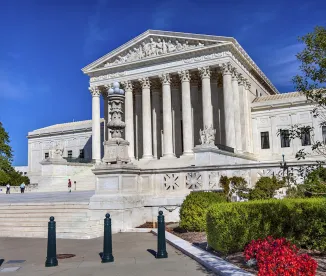Entities regulated by the Consumer Financial Protection Bureau (“CFPB”), including banks, credit unions, payday lenders, mortgage servicers, debt collectors, and other financial services providers, should take note that the Second Circuit has held that the CFPB’s funding structure does not violate the Appropriations Clause of the Constitution. Further, CFPB-regulated entities should pay close attention to the Supreme Court of the United States’ forthcoming decision on the constitutionality of the CFPB’s funding structure. If the CFPB’s funding structure is held to be unconstitutional, the bureau’s future operations will be in jeopardy without action from Congress.
In Consumer Financial Protection Bureau v. Law Offices of Crystal Moroney, P.C., No. 20-3471 (2d Cir. March 23, 2023), the United States Court of Appeals for the Second Circuit (“Second Circuit”) held that the Consumer Financial Protection Bureau’s (“CFPB”) funding structure is constitutional. In doing so, the Second Circuit affirmed the decision of the United States District Court for the Southern District of New York (“District Court”) upholding the enforceability of an investigative demand served by the CFPB on a debt collection law firm.
Background
In June 2017, the CFPB issued a civil investigative demand (“CID”) to the Law Offices of Crystal Moroney, P.C. (“Moroney”), in response to which Moroney produced thousands of pages of documents and other information. However, Moroney withheld a subset of documents, claiming the production of such documents would violate ethical obligations to her clients. In November 2019, the CFPB sought to enforce the CID in District Court. However, shortly before the scheduled hearing, it withdrew the CID and the Court denied the petition to enforce the CID as moot.
The CFPB subsequently issued a second CID, which demanded similar documents to the 2017 CID, and again moved to enforce the same in the District Court. While the petition was pending, the Supreme Court of the United States (“SCOTUS”) issued its decision in Seila Law LLC v. Consumer Financial Protection Bureau, 140 S. Ct. 2183 (2020). In Seila Law, the Court held that the CFPB’s structure involving a single Director who could only be removed “for cause” violated the separation of powers, recognizing that the President may generally remove officers at will.
The decision in Seila Law prompted the CFPB to file a Notification of Ratification purporting to ratify its second CID. In August 2020, the District Court granted the CFPB’s petition, and Moroney appealed, arguing: 1) the CID was void ab initio under Seila Law; 2) the funding structure of the CFPB violates the Appropriations Clause of Article I of the Constitution; 3) Congress violated the nondelegation doctrine when it created the CFPB’s funding structure; and 4) the CID is an unduly burdensome administrative subpoena.
The CID Is Not Void Ab Initio under Seila Law
In her first argument, Moroney alleged that the CID was void ab initio because, when the CID was issued, the CFPB Director was shielded by an unconstitutional removal provision.
In Seila Law[1] and Collins v. Yellen,[2] SCOTUS ruled on matters involving independent agencies headed by a single director protected from at-will presidential removal—the CFPB and the Federal Housing Finance Agency, respectively. In Collins, SCOTUS held that under “[a] straightforward application of [its] reasoning in Seila Law,” the removal restriction violated the separation-of-powers doctrine. Collins, 141 S. Ct. at 1784. However, SCOTUS also held that the relevant inquiry for determining whether an officer’s actions are void ab initio is whether the officer was “properly appointed,” not whether the officer was properly removable. However, SCOTUS left open the possibility that a party could be entitled to relief if it could show that an unconstitutional provision “inflict[ed] compensable harm” on the petitioner.” Id. at 1789.
Applying this rationale from Collins, the Second Circuit held that to void an agency action due to an unconstitutional removal protection, a party must show that the agency action would not have been taken but for the President’s inability to remove the agency head. Moreover, the Second Circuit noted that there was no dispute that the CFPB Director who had issued the CID was properly appointed. Further, Moroney could not argue that the Director would not have issued the CID but for the unconstitutional removal protection, because the investigation into her practice spanned five CFPB Directors appointed by three different Presidents, all but the first of which were subject to at-will removal at some point during their tenure.
The CFPB’s Funding Structure Does Not Violate the Appropriations Clause
For her second argument, Moroney alleged that the CFPB’s funding structure violates the Appropriations Clause, which precludes the Executive Branch from disbursing money from the Treasury, unless Congress has authorized such disbursement. See Cincinnati Soup v. United States, 301 U.S. 308, 321 (1937). Moroney argued that the Executive Branch determines how much funding is necessary to carry out the CFPB’s mission with no “meaningful guidance, limitation or control” by Congress.
The Second Circuit could find no such “meaningful guidance” test in any Appropriations Clause jurisprudence and also determined that Moroney’s characterization of how the CFPB is funded is inaccurate. Because Congress specifically authorized the CFPB’s funding structure through provisions of the Consumer Financial Protection Act (“CFPA”), the Court held that the CFPB’s funding structure does not violate the Appropriations Clause.
In reaching its conclusion, the Second Circuit expressly declined to follow the United States Court of Appeals for the Fifth Circuit’s (“Fifth Circuit”) decision on the same issue, thereby solidifying a Circuit split. Specifically, in Community Financial Services Association of America, Ltd. v. CFPB, the Fifth Circuit held that the CFPB’s funding structure constitutes a “double insulation from Congress’s purse strings,” which runs afoul of the Appropriations Clause. 51 F.4th 616, 639 (5th Cir. 2022). The Second Circuit opined that there is no support for the Fifth Circuit’s reasoning in the text of the Constitution or the history of the Appropriations Clause.
Congress Did Not Violate the Nondelegation Doctrine
Next, Moroney argued that even if the CFPB’s funding structure does not violate the Appropriations Clause, Congress violated the nondelegation doctrine by enacting the CFPA because it did not articulate an “intelligible principle” limiting the President’s discretion in allocating funds. SCOTUS has held that for a delegation of Congress’s legislative powers to be proper, it must lay down by legislative act “an intelligible principle to which the person or body authorized to [exercise the delegated authority] is directed to conform.” J.W. Hampton, Jr., & Co. v. United States, 276 U.S. 394, 409 (1928).
The CFPA states that the CFPB’s budget is for the payment of the agency’s expenses in carrying out its duties and responsibilities and lists five “objectives” and six “primary functions” of the CFPB. The Second Circuit noted that the standard imposed by the nondelegation doctrine is “lenient,” and that these provisions of the CFPA guiding the CFPB in managing its budget satisfy the “intelligible principle” standard.
The CID Is Not Unduly Burdensome
Moroney also argued that the CID was not enforceable because it was unduly burdensome. The Second Circuit noted that it is the respondent’s burden to show that an agency subpoena is unreasonable, and this burden “is not easily met.” SEC v. Brigadoon Scotch Distrib. Co., 480 F.2d 1047, 1056 (2d Cir. 1973).
Moroney alleged that the CFPB is not permitted to issue CIDs seeking information related to the practice of law. The Second Circuit agreed that Congress specifically prohibited the CFPB from exercising enforcement authority over attorneys practicing law. However, the CID requested information related to Moroney’s debt collection activities and potential violations of the Fair Debt Collection Practices Act, which the Second Circuit deemed not incident to her practice of law.[3]
Conclusion
Because the Second Circuit was not persuaded by Moroney’s arguments, it affirmed the District Court’s decision, upholding the constitutionality of the CFPB’s funding structure. Given the Second Circuit’s decision, which rejected the Fifth Circuit’s decision in Community Financial Services Association of America, the constitutionality of the CFPB’s funding structure is ripe for SCOTUS to decide. Because the CFPB had already appealed the Fifth Circuit’s decision, and SCOTUS has granted certiorari and scheduled argument for the October 2023–2024 term, the Appropriations Clause issue will soon be resolved. CFPB-regulated entities should continue to monitor the outcome of this case given the significant impact it may have on the Bureau.





 />i
/>i

